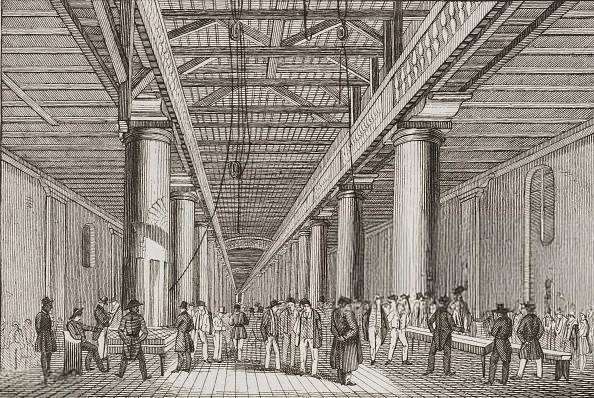Hemp Returns to the Corderie
We have set up our exhibition in a symbolic place: the historic Corderie of the Arsenale in Venice, the incredible Hemp rope factory of the Venetian republic, built in 1579. This hall is so long to provide space for stretching and braiding immense ropes made of Hemp fibers, which would then equip the entire fleet of cargo and war ships that made Venice's wealth and glory.
19th century engraving revealing one of history's greatest industrial secrets: the interior of the Corderie of the Arsenale in Venice, a building over 300m long, where the long Hemp ropes for ships were braided, with which the Most Serene Republic of Venice dominated maritime trade. It is in this building that the Biennale of Architecture takes place today.
This historic place where you are is the Corderie of the Arsenale in Venice, the great Hemp rope factory that ensured Venetian dominance of the seas. In the 16th century, a sophisticated production operation functioned here, behind closed doors, under strict industrial secrecy, to the curiosity of spies from all over the world.
Venice always depended on Hemp to exist. Traditionally, the fiber came from Eastern Europe and Central Asia, via the sea trade routes that came from the East, controlled by the Most Serene Republic of Venice. But in the middle of the 15th century, the Ottoman Turks conquered Constantinople and interrupted this route.
To keep the naval industry alive, the Venetians then quickly installed large Hemp plantations in the interior of Veneto, between the cities of Este, Montagnana, and Cologna. In 1579, the city asked the architect Antonio Da Ponte, the creator of the Rialto Bridge, to build a building long enough to stretch, prepare, and braid the hemp fibers arriving from the interior, continuously producing ropes to operate Venice's fabulous naval fleet.
For centuries, one of the most incredible factories in the world operated here, whose processes and structure were kept in complete secrecy. The only drawings you will find of this space are engravings made only in the 19th century, long after the end of the factory's operations.
In 1797, the French, led by Napoleon, invaded Venice, overthrew the republic, and stopped the production of the Arsenale and the Corderie. Thus ended a history of glory and Hemp. Which we are resuming 228 years later.
